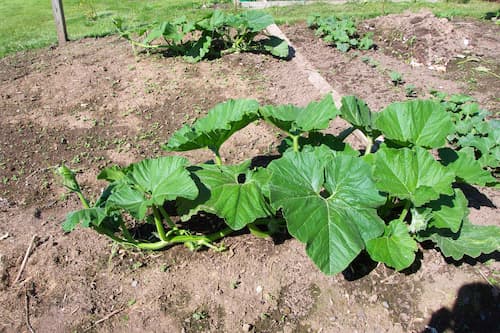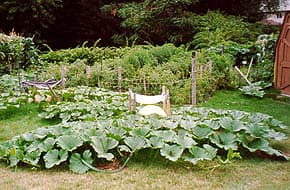
Sometime between selecting the seeds and the actual planting date, the bed for your pumpkin plants should be prepared. The tips and instructions below will help you in this very important step. If you do not have the time or all of the ingredients to completely prepare your pumpkin patch, do not worry. You can still grow a very large monster. And, perhaps you have your own secret methods, which work even better. So, let’s explore how to prepare the pumpkin patch.
Pumpkin plants need to grow in full sun. Select a site for your pumpkin patch that receives as much sunshine as possible. As with any vegetable garden plant, the more sunlight the better. You want to provide the leaves with maximum sunshine. The object is to help maximize the photosynthesis process, and therefore, produce the largest plant and fruit.
Secondly, it helps keep the plant leaves drier earlier in the day and later at night, minimizing the time that moisture and dew are on the leaves. In sultry summer nights, this moisture can promote plant disease, a real danger to your crop.
Some farmers say that the direction of the plant’s vines is important. The theory is that the vine should grow from East to West. However, the maximum sun exposure of the leaves is not impacted by the direction of the vine. Another suggestion is that an inclined pumpkin patch with a southern facing exposure is preferable. If your patch is on a hill, then a southern exposure affords the most hours of sunlight, especially in the waning days of summer, when those final pounds are being added to your fruit, and its orange color is brightening.
One of the greatest assets for a pumpkin patch is the existence of a high water table. The roots will dig deeply into the soft and rich soil you have provided. Those deep roots are seeing an abundance of water and nutrients. An old Italian friend of mine related his days of farming back in the “old Country” (back home in Italy) where he grew up on a farm. He said they used to grow pumpkins near a creekbed, where the water table was closer to the surface of the soil. And, each year their pumpkin patch produced monster pumpkins! However, he said you did risk losing them, if a major downpour flooded out the creek.
Keep in mind the basic principles of crop rotation. Whenever possible, do not grow a crop in the same location two years in a row. This applies to all crops. Pumpkins are no exception. So, plan on moving your pumpkin patch around, if possible. Crops deplete certain minerals in the soil. Planting different crops minimizes this problem. Also, different crops add to your soil, as they are tilled or plowed in at the end of the year.
Secondly, disease can overwinter in the soil and infest the following year’s crop. Ideally, you should rotate your crops in a three-year cycle. This applies to everyone from backyard gardeners to commercial growers. As you rotate your crops, think in terms of family. Move your pumpkin patch each year, and do not plant any members of the cucurbita family in that space.
First, start your pumpkin patch by digging out a four or five-foot pit, about two to three feet deep. Fill this pit with manure and compost materials. I use very little natural soil in the pit. Everyone has their favorite compost ingredients and amendments that they add to the soil. See soil amendments. By using lots of rich materials, you will have a nutrient rich and soft composition for the pumpkin roots to grow in. Be careful not to compact the soil. Compacting the soil makes it more difficult for the roots to spread, defeating the effort you put into preparing the soil.
Next, allow ample time for decomposition. If the material is not well composted, it can be harmful to the plant, burning the roots, or robbing nitrogen from the soil. I like to prepare the bed well before the season. If I can get into the garden in March, I will prepare it then. That way, anything I put in is well composted by planting time.
Everyone has their own secret ingredients to add, using more or less than I’ve listed above. Many growers will mix these components with native soil. If your soil is rich in nutrients and compost, go ahead and use it. If you have heavy clay or sandy soil, you will want to use only a little of the native soil.
The overwhelming majority of growers “mound ” their soil. Mounding is simply creating a hill or raised area where you plant your seeds or seedling. This mound is several inches higher than the surrounding soil. The concept of mounding your soil is not new to growing. It has been used for centuries. While we often talk about mounding(or hilling) pumpkins and squashes, it is also used on a wide variety of crops. For example, I mound rows of peas.
There are two benefits of creating a mound or hill for your plants and both are for early season growth. First, mounding will allow for better drainage. Spring rains often bring more moisture than the plant needs and could promote bacteria growth, damping off disease or “drowning” of the roots by depriving the roots of oxygen. Secondly, the raised soil allows better heating of the seedling and soil around it in the cooler, early spring days.

Preparing the soil in your pumpkin patch where your seedling is planted and the main tap root is located is very important. But, preparing the soil around the whole area where the pumpkin’s vines will spread is equally important, and may be the difference between a large pumpkin and a prize winner.
Soil condition beyond the bed is important because the pumpkin sends out secondary roots along the entire vine system. Enriching the soil wherever the vine travels will result in bigger pumpkins.
The soil should be rich in nutrients and neutral in ph. Add amendments to the soil such as well-rotted manure and decomposed compost in generous amounts. Then, thoroughly mix the amendments into the existing soil. You cannot put too much manure and compost into the area where the pumpkin will eventually grow. At the same time, you probably cannot make the soil as rich nor add amendments as deeply as at the planting site for the seedling. It is simply too much work. Just remember to make sure whatever you add is completely decomposed.
One giant pumpkin plant can cover several hundred square feet of space by the end of the growing season. Does this mean that you cannot grow a monster in your suburban backyard? Do you have to dig up the lawn all the way to your deck? Unless your backyard is very small, you are in luck. You will need to sacrifice some lawn space during the last half of the summer. But, most of the grass under the plants will survive the invasion of your leaves and vines.
Suburban growers with limited space should plant pumpkins at the edge of the pumpkin patch. Then, let the vines grow out along the yard. Cut the lawn near the vines carefully. As the vine spreads across the lawn, place compost in a line along the vine’s path. Three to four inches deep is sufficient. Train the vine along this path. In a short amount of time, the vine will grow secondary roots. The grass will continue to grow. But, it will not affect the health of the plant.
More importantly, you have not caused serious or permanent damage to the lawn. At the end of the season, remove the vines from the lawn and cut the lawn. Overseed any damaged area with new grass seed. Next spring the lawn will look as good as new. This technique does not promote root growth along the secondary vines, but this is a small concession.
People who like this article on how to prepare the pumpkin patch will also like:
How to Improve Your Garden Soil – Growing pumpkin plants to produce the biggest fruit.


